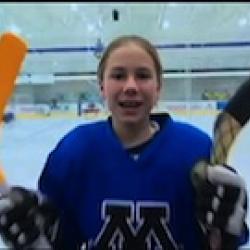Source Institutions
Source Institutions
Add to list Go to activity
Activity link broken? See if it's at the internet archive

This activity (on page 2 of the PDF under SciGirls Activity: Hockey) is a full inquiry investigation into how a hockey stick’s flex affects shooting power and accuracy. Groups of learners will gather hockey sticks with three different flex ratings. Then, they design separate accuracy and speed tests to gather data and calculate average scores for each flex rating. Relates to linked video, DragonflyTV: Hockey.
- 10 to 30 minutes
- 1 to 2 hours
- Over $20 per group of students
- Ages 8 - 14
- Activity, Experiment/Lab Activity, Field Trip
- English
Quick Guide
Materials List (per group of students)
- hockey rink
- hockey net, pucks and sticks of different flex ratings
- tape measure
- paper target to place in the net
- sports radar gun (such as the SpeedChek 2000 TM)
Subjects
-
Engineering and Technology
-
Engineering
- Metallurgy and Materials Engineering
-
Engineering
-
Mathematics
-
Data Analysis and Probability
- Data Analysis
- Data Collection
- Data Representation
-
Measurement
- Rate
- Representation
-
Data Analysis and Probability
-
The Nature of Technology
-
The Design Process
- Invention and Innovation
-
The Design Process
-
Physical Sciences
-
Energy
- Work and Machines
-
Motion and Forces
- Momentum and Velocity
- Acceleration
- Projectile Motion
-
Energy
-
The Nature of Science
-
The Scientific Process
- About Inquiry
- Asking Questions
- Conducting Investigations
- Gathering Data
- Formulating Explanations
- Communicating Results
-
The Scientific Process
Informal Categories
- Physical Activity
- Sports and Exercise
Audience
To use this activity, learners need to:
- see
- read
- be mobile
- touch
Learning styles supported:
- Involves teamwork and communication skills
- Uses STEM to solve real-world problems
- Involves hands-on or lab activities
Culture, ethnicity, and gender
-
Girls
- Explicity developed for this group
- Addresses bias against this group
- Highlights STEM opportunities for this group
- Identifies role models or mentors in STEM fields from this group
- Uses inclusive images of people from this group
Other
Components that are part of this resource:
This resource is part of:
Access Rights:
- Free access
By:
Source Collection
- DragonflyTV
Rights:
- All rights reserved, Twin Cities Public Television, Inc., 2005
Funding Source:
- National Science Foundation, 436260
